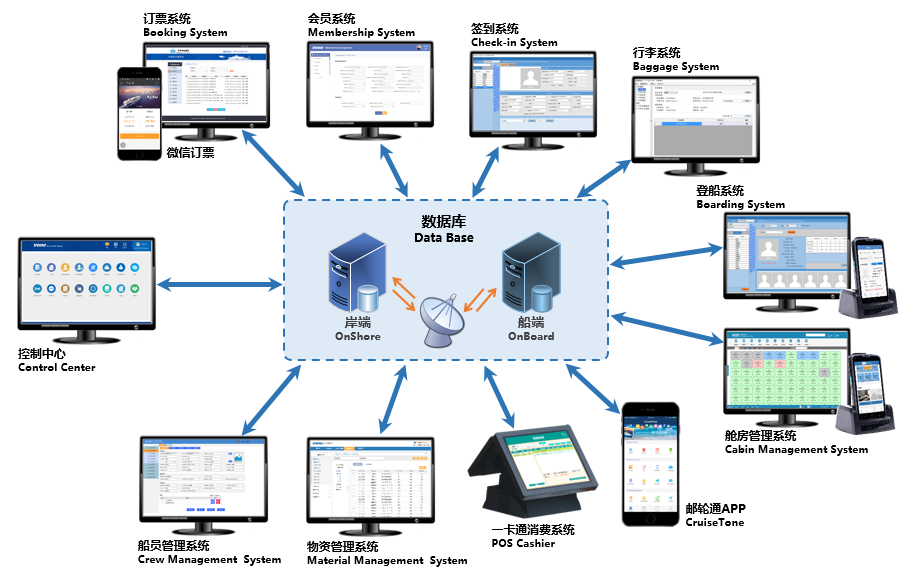In the modern maritime industry, efficient, secure, and reliable network management is essential for ensuring the safety, operational efficiency, and profitability of commercial vessels. Leveraging cloud-managed network infrastructure offers several advantages, such as centralized management, real-time monitoring, scalability, and remote troubleshooting.
Centralized Network Management
- Cloud-managed network solutions provide a centralized platform to monitor, configure, and troubleshoot all network devices on the vessel (routers, switches, access points, firewalls, etc.).
- Network configurations can be remotely updated and pushed to devices, ensuring consistency and minimizing manual effort.
- Administrators can access the management interface from anywhere, enabling proactive intervention in case of issues, even while the vessel is out at sea.


Seamless Connectivity for Remote Operations
- Cloud-managed networks ensure that the vessel is always connected to shore-based management systems, communication platforms, and remote monitoring systems.
- This provides real-time data transfer for critical systems such as navigation, engine management, cargo tracking, and more, reducing delays and improving decision-making.
- Satellite, 4G/5G, and Wi-Fi are integrated into the network, ensuring seamless connectivity even in remote maritime locations.
Scalability & Flexibility
- The cloud model allows for easy scaling of network infrastructure. As more devices are added to the vessel or more data needs to be processed, the cloud infrastructure can expand to meet demand.
- You can scale bandwidth, storage, and compute resources dynamically, without worrying about the physical limitations of onboard hardware.


Enhanced Security and Compliance
- With cloud-managed networks, advanced security measures such as encryption, access control, and intrusion detection can be implemented across the entire network infrastructure.
- Regular software updates and patches can be applied remotely to ensure that the latest security features are always in place.
- Compliance with maritime regulations (e.g., IMO Cyber Risk Management, GDPR) is made easier with cloud-based solutions, as centralized monitoring ensures adherence to security standards.
Optimized Operational Efficiency
- Real-time monitoring of network performance ensures that vessel operations are running smoothly and any issues can be quickly identified and addressed.
- Automated network diagnostics and troubleshooting help reduce downtime by providing insights into potential issues, enabling timely corrective actions.
- A cloud-managed network allows for predictive maintenance, where data analytics can identify patterns and predict when equipment might fail, enabling repairs before failures occur.

Core Components of a Cloud-Managed Network Infrastructure
1. Cloud-Managed Routers and Switches
- Network devices such as routers and switches are managed from the cloud, offering visibility and control over network traffic, optimizing data flows, and ensuring efficient bandwidth allocation.
- Automatic configuration updates, security patching, and management of IP addresses can all be done remotely, without manual intervention on the vessel.
2. Cloud-Based Wi-Fi and Access Points
- Cloud-controlled wireless networks allow for the provision of reliable onboard Wi-Fi for crew, passengers, and critical systems.
- Wi-Fi access points can be centrally managed to ensure strong coverage across the entire vessel and optimize user experiences, whether for navigation, communication, or entertainment.
3. Virtual Private Networks (VPNs)
- Cloud-managed VPNs provide secure communication between the vessel and shore-based systems, ensuring that sensitive data is transmitted securely over the network.
- VPNs help protect the vessel’s network from cyberattacks, especially when operating in remote locations with satellite communication or public networks.
4. Edge Computing Integration
- While the cloud manages the overall network, edge devices onboard the vessel can handle local data processing, ensuring that latency-sensitive applications (such as navigation or safety systems) can operate in real-time.
- These edge devices can communicate with the cloud to share data or receive updates, maintaining the vessel’s operations even in case of intermittent connectivity.
5. Remote Monitoring and Troubleshooting
- Cloud-managed solutions provide real-time visibility into the health of all network devices, services, and systems onboard. Issues can be detected before they escalate into critical failures.
- Automated alerts and diagnostics help network administrators respond quickly to network disruptions, minimizing downtime and ensuring continuous operations.
Use Cases for Cloud-Managed Network Infrastructure on Commercial Vessels
1. Fleet Management and Remote Monitoring
- Cloud-managed network infrastructure allows fleet operators to remotely monitor the health, location, and operational status of all vessels in their fleet.
- Operators can track vital metrics such as fuel consumption, speed, location, and weather conditions, enabling better decision-making and reducing operational costs.
2. Enhanced Crew Connectivity
- Offering stable, high-speed internet to the crew allows them to stay connected with family, access training materials, and communicate with the shore team, improving overall morale and productivity.
- Voice and video calls can be supported over the network, enabling real-time communication with the operations center and enhancing decision-making processes during critical situations.
3. Data-Driven Navigation and Operations
- With a cloud-managed network, onboard systems can collect and transmit operational data to the cloud for advanced analytics.
- This enables data-driven navigation, fuel optimization, and improved route planning, which can reduce costs and enhance vessel efficiency.
4. Autonomous and Semi-Autonomous Operations
- For vessels with autonomous navigation or semi-autonomous systems, cloud-managed networks provide reliable connectivity to ensure that data from the vessel’s sensors and AI algorithms is transmitted to remote command centers for processing and oversight.
- Cloud platforms can push updates to onboard systems to refine the autonomous behavior or respond to changes in environmental conditions in real-time.
5. Cybersecurity and Regulatory Compliance
- Cloud management enables continuous monitoring for cybersecurity threats. Any breaches can be quickly detected and addressed, ensuring the integrity of the vessel’s network.
- Automated security patches and updates can be deployed remotely, ensuring that the vessel remains compliant with maritime cybersecurity regulations.
How It Works: A Seamless Cloud-Managed Network Architecture
- Onboard Network Devices (Routers, Switches, Access Points) connect to the cloud via satellite, 4G, or 5G networks.
- The Cloud Management Platform provides centralized monitoring, configuration, and troubleshooting tools for administrators.
- Remote Monitoring and Diagnostics are performed continuously, with automated alerts for potential issues.
- Security Management such as VPNs, encryption, and intrusion detection are implemented across the network to protect against cyber threats.
- Data Analytics collected from the vessel’s systems and sensors are sent to the cloud for real-time processing or long-term storage for future analysis.
Conclusion
A cloud-managed network infrastructure for commercial vessels allows for seamless, secure, and efficient operations across various onboard systems. By centralizing network management, enhancing connectivity, and enabling real-time data exchange, this solution improves operational efficiency, reduces costs, and ensures compliance with security standards. Cloud-managed solutions are particularly valuable for large fleets, autonomous vessels, and vessels operating in remote locations, where reliable connectivity and data-driven decision-making are paramount.

